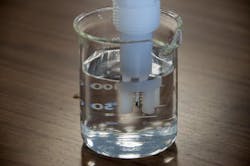Cleaning & Calibrating Sensors
You can reach Endress+Hauser at www.us.endress.com or 888.363.7377.
undefinedAll pH sensors require cleaning. They should be cleaned with a non-ionic detergent and rinsed with clean water. A soft-bristle brush can help remove stubborn buildup. A weak or dilute acid can help remove scale and buildup. Proper sensor cleaning is critical to insure rapid response time and measurement stability. Thorough cleaning must be accomplished before sensor calibration to make certain that process residue has no impact on the pH measurement while the sensor is in buffer solutions.
The Importance of Regularly Cleaning Sensors
Endress+Hauser employees went to see a customer that was having some problems with his pH systems. The customer said he liked everything the company makes except its pH equipment. According to the customer, the sensors keep drifting.
The customer had six identical tanks with one pH sensor on each tank. The customer and Endress+ Hauser employees went to the first tank and observed the pH reading. The customer called down to the control room to verify what the pH value should be based on their recipe. The sensor read about one pH off. He explained that he calibrated it yesterday, and it has drifted by one pH. The employees asked if he could show them how he does cleaning and calibration.
They proceeded to pull the sensor out, rinse it with water and put it in buffers. In the 7 buffer, it read 6. They put it in the 4 buffer, and it read 3.
They put the sensor back in the 7 buffer and were ready to hit the calibrate button when the one of the Endress+Hauser employees said, “Hold on, how are you going to clean the sensor?”
The customer was confused.
“We just did!” he said. “Didn’t you see that step?”
“Well you rinsed it off, but you didn’t really clean it,” the employee said.
The customer was under the impression he could not clean the device any other way. Based on the employee’s experience of similar processes, he told the customer he probably has a lot of fats, oils and greases in his sensor.
“Let’s pour a few drops of liquid dishwashing soap into a cup of warm water,” the employee said.
They immersed the sensor in the soapy water, swirled it around and dipped a paper towel into the water to gently clean the electrode area. They then put it back into the 7-buffer solution. It then read 7 pH.
They rinsed off the sensor and placed it in the 4 buffer and it read 4 pH. The customer was very satisfied.
They went to tank number two and had the exact same scenario with the same results. When they went to tank number three, they once again had the same results. They were ready to go to tank four and the customer said, “I got it, thank you very much, we learned a lot today.”
Endress+Hauser employees feel good when they leave a customer site after they are able to fix issues and get it back up and running. In most cases, these types of problems can be avoided by following manufacturer operating and installation information and keeping the pH sensors clean and calibrated.
